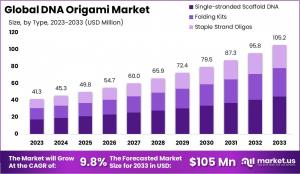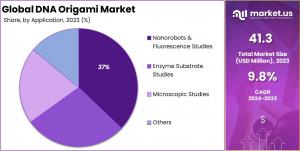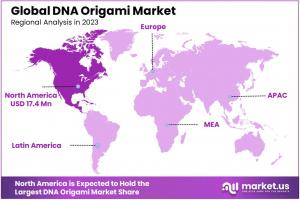DNA Origami Market Poised for USD 105.2 Million Valuation by 2033 at 9.8% CAGR
DNA Origami Market size is expected to be worth around USD 105.2 Million by 2033, from USD 41.3 Million in 2023, at a CAGR of 9.8%.
NEW YORK, NY, UNITED STATES, February 19, 2025 /EINPresswire.com/ -- The Global DNA Origami Market is projected to reach USD 105.2 million by 2033, growing from USD 41.3 million in 2023 at a CAGR of 9.8% from 2024 to 2033. DNA origami, a technique that folds DNA molecules into precise nanoscale structures, is gaining traction in medical and nanotechnology applications. Its ability to create customized, self-assembling structures is driving advancements in drug delivery, diagnostics, and material science. Research institutions and biotechnology firms are actively exploring its potential, making this field a key area of innovation.A major factor fueling market expansion is the use of DNA origami in medicine. Scientists are leveraging this technology for targeted drug delivery, ensuring precise treatment of diseased cells while minimizing side effects. This technique enhances treatment accuracy, particularly in cancer therapy, by delivering drugs directly to tumors. The ability to program DNA structures for controlled drug release is a significant advancement, increasing interest from pharmaceutical companies. Additionally, DNA origami is being tested for gene therapy applications, where it plays a role in correcting genetic disorders.
Another crucial driver is its role in diagnostics and biosensors. DNA origami-based sensors are highly sensitive and capable of detecting RNA, DNA, proteins, and small molecules. These sensors improve early disease detection, providing more accurate diagnostic tools for conditions such as cancer and infectious diseases. The ability to create precise nanoscale structures allows for highly efficient molecular recognition, making DNA origami an essential tool in biomedical research and personalized medicine. As a result, this technology is expected to revolutionize disease monitoring and diagnostic procedures.
Innovations in nanotechnology and material science further contribute to the growing adoption of DNA origami. When combined with polymers, DNA origami enables the development of 100-nanometer structures used in biotechnology, electronics, and materials engineering. This integration opens new avenues in biomedical implants, drug carriers, and nanoelectronics, where precision and self-assembly capabilities are crucial. Researchers are also exploring the use of DNA origami in artificial enzyme design, which could lead to breakthroughs in synthetic biology and industrial catalysis.
Government initiatives are also supporting the development of DNA origami technology. In India, the Department of Biotechnology (DBT) is investing in research and innovation to advance nanotechnology applications. This support fosters scientific collaboration and funding, accelerating the commercialization of DNA origami-based solutions. With continued research and technological advancements, the DNA origami market is expected to grow significantly, driving innovations in medicine, diagnostics, and material science.
Get Sample PDF Report: https://market.us/report/dna-origami-market/request-sample/
Market.Us has recently published a detailed research report on the 'DNA Origami Market', offering a comprehensive view of the market's global and regional prospects. This report provides a thorough analysis of the latest industry developments and the major players shaping the DNA Origami industry. It outlines the market scenario clearly, presenting specifications and industry procedures in an organized manner. This structured presentation of information aids readers in gaining a deep understanding of the industry, focusing on the stability of cost and revenue structures.
The primary goal of this report is to deliver factual, actionable data about the DNA Origami market. It equips readers with the necessary information to formulate and execute informed strategies based on the extensive data provided. The report includes detailed market statistics that offer insights into the current market status, future projections, and classifications based on various criteria such as product type, end-use, and region.
The report thoroughly covers the classification of the DNA Origami market, highlighting significant aspects like product types and the main industries associated with the DNA Origami Market. It also delves into critical industry dynamics such as development trends, supply, and demand conditions. This analysis provides a deep understanding of the market's current landscape and growth trajectory over the years.
Furthermore, the report extensively analyzes business plans, sales, and profitability to enhance readers' understanding of the DNA Origami market. It discusses essential elements like production volumes, sales data, key raw material suppliers, and buyers in the industry. These details are crucial for understanding the informational needs and distribution rates within the market.
Key Takeaways
• The DNA Origami Market is expected to rise from USD 41.3 million in 2023 to USD 105.2 million by 2033, growing at a 9.8% CAGR.
• Single-stranded Scaffold DNA led the market in 2023 with a 42.3% share, as it plays a vital role in constructing DNA origami structures.
• Nanorobots & Fluorescence Studies dominated the applications, securing a 37.2% market share, driven by its importance in nanomedicine and bioresearch advancements.
• Growth in the market is fueled by nanotechnology advancements and precision medicine, enhancing the role of DNA origami in targeted therapies.
• Technical challenges in designing DNA origami and high production costs pose significant barriers, restricting widespread research and commercial adoption.
• DNA origami is integral to nanorobotics, offering new opportunities in developing nanoscale robots for precise drug delivery applications.
• The integration of DNA origami with CRISPR-Cas9 gene-editing technology is a key trend, advancing genetic research and therapeutic developments.
• North America led the market with a 42.1% share in 2023, supported by robust biotech infrastructure and increased R&D investments.
Get Sample PDF Report: https://market.us/report/dna-origami-market/request-sample/
MARKET INSIGHT AND COMPETITIVE OUTLOOK
The Competitive Landscape section of the DNA Origami market report offers an in-depth analysis of the leading players currently influencing the market. This segment highlights the strategic efforts and steadfast dedication of these companies as they seek competitive advantages. Users gain insight into the methods employed by these key market influencers through detailed evaluations.
This section includes comprehensive COMPANY PROFILES that provide a snapshot of each leading player. Details such as company history, business focus, and market position are outlined, giving readers a clear view of who shapes the market landscape.
Additionally, the report covers COMPANY OVERVIEWS and FINANCIAL HIGHLIGHTS, offering a lens into the economic health and investment priorities of these entities. This financial analysis helps stakeholders understand the funding dynamics and revenue streams that propel these companies forward in the competitive arena.
Lastly, PRODUCT PORTFOLIOS, SWOT ANALYSES, KEY STRATEGIES, AND DEVELOPMENTS are meticulously presented. This information serves to reveal the strengths, weaknesses, opportunities, and threats each company faces, alongside their strategic moves and innovations in product development, allowing for a rounded understanding of their market presence and growth tactics.
The Primary Entities Identified In This Report Are:
• DNA Technologies IDT
• Tilibit Nanosystems GmbH
• Eurofins Genomics
• Twist Bioscience Corporation
• GATTAquant DNA Technologies
• Dietz Lab
• ADINA R&D Inc.
• Technalia
• Kosuri Lab
• Cees Dekkar Lab
• Other Key Players
SEGMENTATION PERSPECTIVE
The report provides an extensive segmentation of the DNA Origami market, focusing on diverse product types, end-users, and geographical regions. It details a thorough analysis of selected market segments from 2020 to 2023, with forward-looking forecasts extending from 2025 to 2034. Each segment is assessed based on revenue generation (in million USD) and Average Annual Growth Rate (CAGR), offering a clear perspective on market dynamics.
This study includes a detailed regional breakdown that encompasses key areas such as North America, Asia-Pacific, Europe, South America, the Middle East, Africa, and the Rest of the World. The analysis highlights regional market trends, growth drivers, and potential opportunities, providing stakeholders with essential insights for strategic decision-making.
Additionally, the report delves into various product types within the DNA Origami market. It examines each product category for its revenue contribution and growth prospects over the forecast period. This segment-centric approach helps identify which product types are gaining traction and their impact on the overall market landscape.
Lastly, the target applications associated with the DNA Origami market are explored. This section assesses how different applications influence market growth and development. The report’s comprehensive coverage of target applications aids industry participants in understanding specific market demands and adjusting their strategies accordingly.
Key Segments Covered In This Report Are:
Type
• Single-stranded Scaffold DNA
• Folding Kits
• Staple Strand Oligos
Application
• Nanorobots & Fluorescence Studies
• Enzyme Substrate Studies
• Microscopic Studies
• Others
Buy Directly: https://market.us/purchase-report/?report_id=84817
WHAT TO EXPECT IN OUR REPORT?
• The report analyzes key market drivers, challenges, opportunities, and trends shaping the DNA Origami industry.
• It examines growth potential, consumption, and industry share across key regions and countries influencing market expansion.
• The report helps businesses refine strategies by analyzing top players' performance and competitive challenges in the DNA Origami industry.
• It covers industry mergers, acquisitions, company expansions, and market concentration rates, highlighting the top players' market shares.
• The report presents well-researched conclusions and insights to help businesses navigate the Global DNA Origami market effectively.
• What potential opportunities exist for new entrants in the Global DNA Origami industry?
• Who are the key companies driving growth in the DNA Origami sector?
• What strategies are businesses adopting to expand their market presence and competitive edge?
• How is competition shaping the DNA Origami industry?
• What new trends may influence future market growth and industry developments?
• Which product types are projected to witness the highest compound annual growth rate (CAGR)?
• Which application segment is expected to dominate the Global DNA Origami industry?
• Which geographical region presents the most lucrative opportunities for manufacturers?
*Note: We offer customized market research reports tailored to meet your specific business needs and requirements.
CONCLUSION
The DNA origami market is rapidly growing, driven by its potential in medicine, diagnostics, and nanotechnology. This technology allows precise nanoscale structures that improve targeted drug delivery, gene therapy, and early disease detection. Pharmaceutical and biotech firms are investing in DNA origami to enhance precision medicine and biosensing applications. Innovations in material science and nanorobotics further expand its applications. Despite technical challenges and production costs, ongoing research and government support are fostering its commercialization. With increasing demand for advanced healthcare solutions and nanotechnology, DNA origami is set to revolutionize drug development, diagnostics, and synthetic biology, making it a crucial innovation in the biotech industry.
GET MORE REPORTS
• DNA Sequencing Market: https://market.us/report/dna-sequencing-market/
• DNA Microarray Market: https://market.us/report/dna-microarray-market/
• Viral Vectors and Plasmid DNA Manufacturing: https://market.us/report/viral-vectors-and-plasmid-dna-manufacturing-market/
• DNA Modifying Enzymes Market: https://market.us/report/dna-modifying-enzymes-market/
• DTC (Direct to Consumer) DNA Test Kits Market: https://market.us/report/dtc-direct-to-consumer-dna-test-kits-market/
• DNA Synthesis Market: https://market.us/report/dna-synthesis-market/
• Plasmid DNA Manufacturing Market: https://market.us/report/plasmid-dna-manufacturing-market/
• DNA Test Kits Market: https://marketresearch.biz/report/dna-test-kits-market/
• Dna Testing Market: https://marketresearch.biz/report/dna-testing-market/
• DNA Diagnostics Market: https://marketresearch.biz/report/dna-diagnostics-market/
• Pet DNA Testing Market: https://marketresearch.biz/report/pet-dna-testing-market/
• Recombinant DNA Technology Market: https://marketresearch.biz/report/recombinant-dna-technology-market/
Lawrence John
Prudour
+91 91308 55334
Lawrence@prudour.com
Legal Disclaimer:
EIN Presswire provides this news content "as is" without warranty of any kind. We do not accept any responsibility or liability for the accuracy, content, images, videos, licenses, completeness, legality, or reliability of the information contained in this article. If you have any complaints or copyright issues related to this article, kindly contact the author above.



